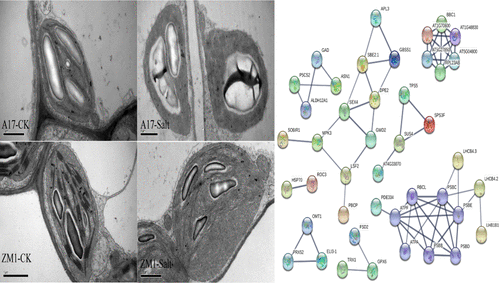当前位置:
X-MOL 学术
›
J. Proteome Res.
›
论文详情
Our official English website, www.x-mol.net, welcomes your feedback! (Note: you will need to create a separate account there.)
Comparative Proteomic Analysis Reveals That Antioxidant System and Soluble Sugar Metabolism Contribute to Salt Tolerance in Alfalfa ( Medicago sativa L.) Leaves.
Journal of Proteome Research ( IF 4.4 ) Pub Date : 2018-10-25 , DOI: 10.1021/acs.jproteome.8b00521 Yanli Gao 1 , Ruicai Long 1 , Junmei Kang 1 , Zhen Wang 1 , Tiejun Zhang 1 , Hao Sun 1 , Xiao Li 1 , Qingchuan Yang 1
Journal of Proteome Research ( IF 4.4 ) Pub Date : 2018-10-25 , DOI: 10.1021/acs.jproteome.8b00521 Yanli Gao 1 , Ruicai Long 1 , Junmei Kang 1 , Zhen Wang 1 , Tiejun Zhang 1 , Hao Sun 1 , Xiao Li 1 , Qingchuan Yang 1
Affiliation

|
Soil salinity poses a serious threat to alfalfa ( Medicago sativa L.) productivity. To characterize the molecular mechanisms of salinity tolerance in Medicago, the comparative proteome of leaves from Medicago sativa cv. Zhongmu No.1 (ZM1, salt-tolerant) and Medicago truncatula cv. Jemalong A17 (A17, salt-sensitive) was performed using the iTRAQ approach. A total of 438 differentially expressed proteins (DEPs) were identified, among which 282 and 120 DEPs were specific to A17 and ZM1, respectively. In salt-tolerant ZM1, key DEPs were primarily enriched in antioxidant system, starch and sucrose metabolism, and secondary metabolism. ZM1 possessed a greater ability to remove reactive oxygen species and methylglyoxal under salt stress, as demonstrated by enhancement of the antioxidant system and secondary metabolism. Moreover, ZM1 orchestrated starch and sucrose metabolism to accumulate various soluble sugars (sucrose, maltose, glucose, and trehalose), which in turn facilitate osmotic homeostasis. Salt stress dramatically inhibited photosynthesis of A17 due to the downregulation of the light-harvesting complex and photosystem II related protein. Quantitative analyses of photochemical efficiency, antioxidant enzyme activities, hydrogen peroxide, malondialdehyde, and soluble sugar contents were consistent with the alterations predicted on the basis of DEP functions. These results shed light on our understanding of the mechanisms underlying the salt tolerance of alfalfa.
中文翻译:

比较蛋白质组学分析表明抗氧化系统和可溶性糖代谢有助于苜蓿(Medicago sativa L.)叶片的耐盐性。
土壤盐分严重威胁苜蓿(苜蓿)的生产力。为了表征紫花苜蓿耐盐性的分子机制,紫花苜蓿叶片的比较蛋白质组。中牟1号(ZM1,耐盐)和Medi藜苜蓿cv。使用iTRAQ方法进行Jemalong A17(对盐敏感的A17)。总共鉴定出438种差异表达蛋白(DEP),其中分别有282种和120种DEP特异于A17和ZM1。在耐盐ZM1中,主要的DEP主要富含抗氧化剂系统,淀粉和蔗糖代谢以及次生代谢。ZM1具有在盐胁迫下去除活性氧和甲基乙二醛的更大能力,这可以通过增强抗氧化系统和辅助代谢来证明。而且,ZM1协调淀粉和蔗糖的代谢,以积累各种可溶性糖(蔗糖,麦芽糖,葡萄糖和海藻糖),从而促进渗透稳态。盐胁迫由于光收集复合体和光系统II相关蛋白的下调而极大地抑制了A17的光合作用。光化学效率,抗氧化酶活性,过氧化氢,丙二醛和可溶性糖含量的定量分析与基于DEP功能预测的变化一致。这些结果为我们对苜蓿耐盐性机理的理解提供了启示。盐胁迫由于光收集复合体和光系统II相关蛋白的下调而极大地抑制了A17的光合作用。光化学效率,抗氧化酶活性,过氧化氢,丙二醛和可溶性糖含量的定量分析与基于DEP功能预测的变化一致。这些结果为我们对苜蓿耐盐性机理的理解提供了启示。盐胁迫由于光收集复合体和光系统II相关蛋白的下调而极大地抑制了A17的光合作用。光化学效率,抗氧化酶活性,过氧化氢,丙二醛和可溶性糖含量的定量分析与基于DEP功能预测的变化一致。这些结果为我们对苜蓿耐盐性机理的理解提供了启示。
更新日期:2018-10-26
中文翻译:

比较蛋白质组学分析表明抗氧化系统和可溶性糖代谢有助于苜蓿(Medicago sativa L.)叶片的耐盐性。
土壤盐分严重威胁苜蓿(苜蓿)的生产力。为了表征紫花苜蓿耐盐性的分子机制,紫花苜蓿叶片的比较蛋白质组。中牟1号(ZM1,耐盐)和Medi藜苜蓿cv。使用iTRAQ方法进行Jemalong A17(对盐敏感的A17)。总共鉴定出438种差异表达蛋白(DEP),其中分别有282种和120种DEP特异于A17和ZM1。在耐盐ZM1中,主要的DEP主要富含抗氧化剂系统,淀粉和蔗糖代谢以及次生代谢。ZM1具有在盐胁迫下去除活性氧和甲基乙二醛的更大能力,这可以通过增强抗氧化系统和辅助代谢来证明。而且,ZM1协调淀粉和蔗糖的代谢,以积累各种可溶性糖(蔗糖,麦芽糖,葡萄糖和海藻糖),从而促进渗透稳态。盐胁迫由于光收集复合体和光系统II相关蛋白的下调而极大地抑制了A17的光合作用。光化学效率,抗氧化酶活性,过氧化氢,丙二醛和可溶性糖含量的定量分析与基于DEP功能预测的变化一致。这些结果为我们对苜蓿耐盐性机理的理解提供了启示。盐胁迫由于光收集复合体和光系统II相关蛋白的下调而极大地抑制了A17的光合作用。光化学效率,抗氧化酶活性,过氧化氢,丙二醛和可溶性糖含量的定量分析与基于DEP功能预测的变化一致。这些结果为我们对苜蓿耐盐性机理的理解提供了启示。盐胁迫由于光收集复合体和光系统II相关蛋白的下调而极大地抑制了A17的光合作用。光化学效率,抗氧化酶活性,过氧化氢,丙二醛和可溶性糖含量的定量分析与基于DEP功能预测的变化一致。这些结果为我们对苜蓿耐盐性机理的理解提供了启示。



























 京公网安备 11010802027423号
京公网安备 11010802027423号